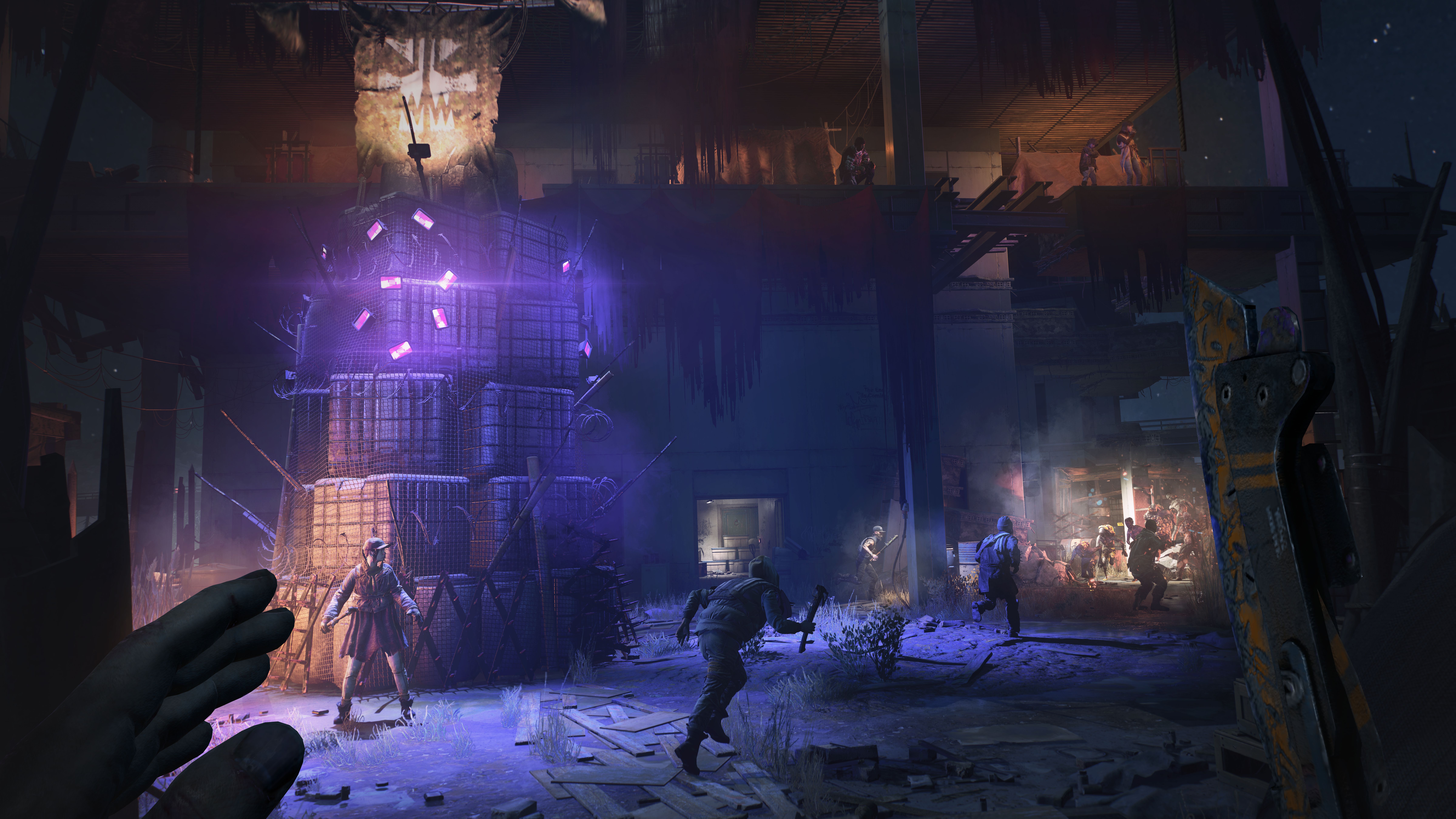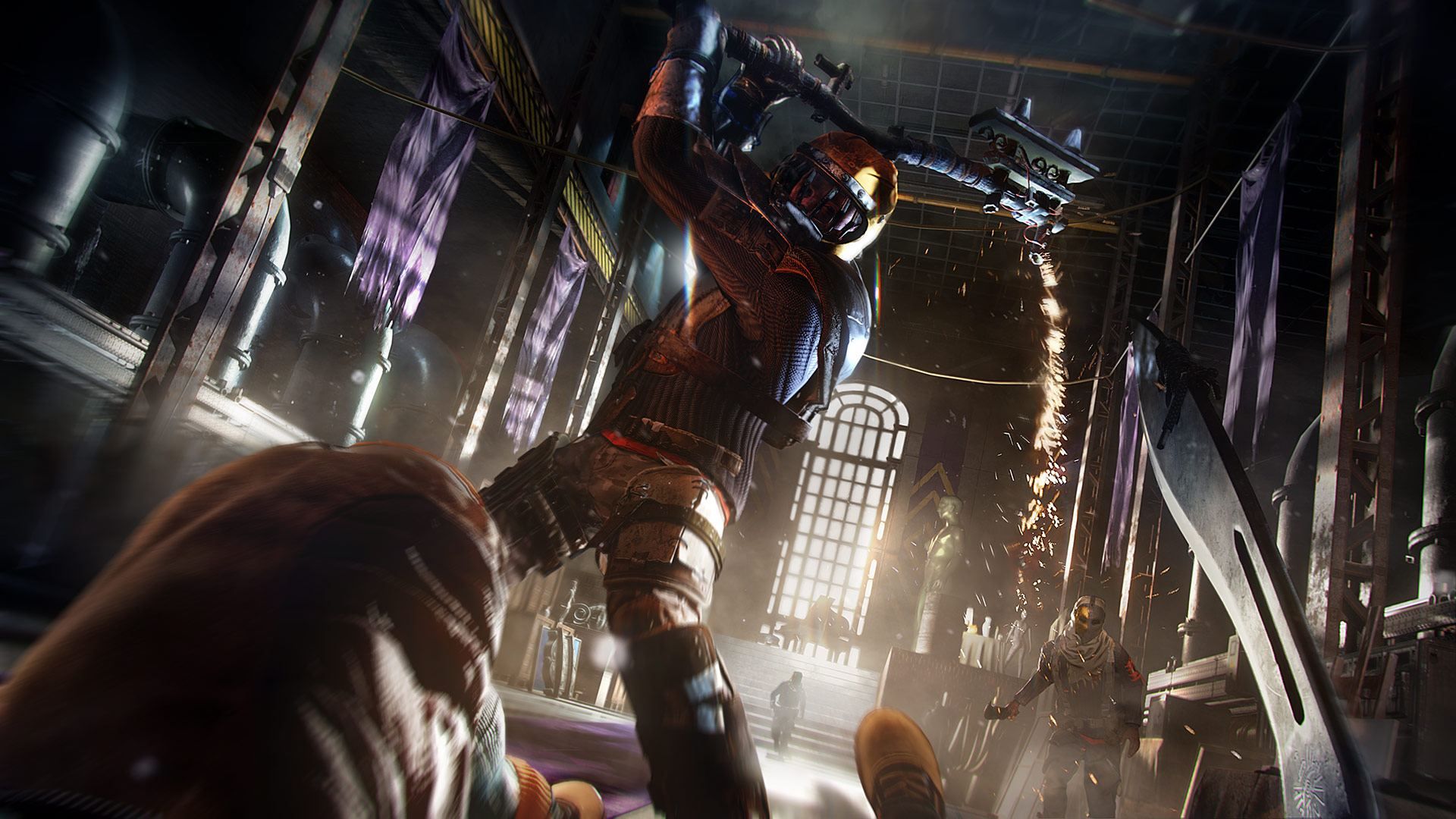So this mission requires more finesse. You need to use all that agility and poise you’ve mastered in Dying Light 2’s impressive parkour ’n’ puching open-world city, sure, but you also need to layer more skills on top of that, cherry-picked from the new toolkit Techland has provided. “We’ve worked on stealth quite a lot on purpose,” lead game designer Tymon Smektała explains. “In Dying Light, we were aiming to create a game where we could put a challenge or a problem in front of you, and you could solve it with the environment. Stealth wasn’t one of the options you could use to solve that, really, in the first game.” Smektała’s right. Dying Light gave you an array of ways to creatively problem-solve your way out of tricky encounters – parkour, ranged weapons, melee, or that ludicrously overpowered grappling hook spring to mind – but being both deadly and sneaky never seemed viable. If you tried to sidle past some heaving undead behemoth, you were liable to get your skull smashed into the wall. For players like me, that wasn’t ideal. “We really wanted to add another module, another chunk of options, for you to consider when thinking about how to overcome what we’re throwing at you,” continues Smektała. And that’s obvious when you get to grips with stealth in Dying Light 2. Perhaps the best measure of success for how stealth works in the game comes when you try sneaking against the infected versus trying it against humans. Shambling zombies make for good target practice if you’re a fleet-footed bowman, thanks to their habit of standing around (even if some of them do like to tuck their little heads between their legs when they’re resting, making one-hit kills nigh-impossible). It’s not so hard to sneak into a lair of zombies - but mess up your route and you’ll be in the thick of them, easy prey and incredibly vulnerable. “The whole mechanic of going inside ‘dark zones’ and trying not to wake [the infected] up… it’s a little bit different, and it’s something we’ve had in Dying Light 2 since the very beginning,” explains Smektała. “But we also knew we wanted to give you the opportunity to interact more with humans, both in combat and in dialogue, so a huge part of our development schedule – in animation, programming, everything – was dedicated to making stealth work against human AI as well as the undead.” By contrast Humans are smarter, tend to have better eyesight, and in the preview build I played, slightly smarter AI (though that element of the game did leave a lot to be desired in general). Thanks to some distraction techniques you can employ that seem very ‘inspired’ by The Last of Us II, though, you can distract human enemies and guide them away from your planned path – or into a trap. Smektała isn’t trying to hide that inspiration. “Hearing you mention the similarities to The Last of Us II,” he says, “is like ‘honey on my ears’, as we say in Poland. We were intentionally working to make [the stealth] feel like that.” The game’s (much improved, more detailed) sound design plays into this renewed focus on stealth, too. Smektała explains that the first game’s approach to noise was incredibly simple: “make noise, attract virals”. In Dying Light 2, it’s less rudimentary. “There is a whole system related to noises,” he explains, governing how different enemies react to them, how strong those reactions are, and how they’re prioritised when they overlap. It is, he says, difficult to script, but hopefully makes stealth both more rewarding and more viable. To test out how responsive this new sound system is, I played through a dark zone full of zombies in two separate ways. First, I did it ‘properly’, all hidden and quiet, finding special infected and popping headshots at range before using silent melee takedowns on chains of undead; a methodical zone-by-zone clearout. It was all very wetwork, very clinical, and was the highlight of my hands-on with the game. The second run, I went running in, torch on, seeing flashes of claws and fangs lunge at me between heavy swings of my improvised mace (made mostly out of a road sign). I was dead within minutes. You can tell Techland want to position this game, at least in part, to be a stealth-lover’s dream. Whilst it doesn’t have the tactical focus of Metal Gear Solid, or the particularly sophisticated hidden/unhidden mechanics of Thief, it still does stealth a damn sight better than the majority of its open world FPS contemporaries (here’s looking at you, Far Cry). A lot of the satisfaction in netting stealth kills or slipping by hordes of enemies unseen comes from Dying Light 2’s more responsive skill trees, something that Smektała – creator of the first game’s impressive action-cum-RPG interpretation of the system – was keen to address in the sequel. He was unhappy with some of the skills that were stat-based number multiplyers. “For the second game, we wanted every skill to almost be game-changing,” he says, “giving you a new opportunity that you can fall in love with and play with and experiment with.” Smektała notes that Dying Light 2 has been designed, very intentionally, with intersecting systems, skills and techniques in mind. The game is built on myriad moving parts that are designed to interact and compliment each other. “It’s a game that rewards players that are creative and experimental, and who find their own solutions and are able to make connections between various game systems,” he explains. Perhaps my doomed loud attempt at clearing out that damn car park would have been a little more successful if I’d gone in quietly first, used the precision shot skill I’d unlocked with the bow to pick off the more high-priority targets, then gone loud towards the end of the skirmish, hopping off the back of a stunned zombie and slamming my improvised mace into a group, before sprinting off to preserve what little life I had left. When the full game launches on February 4, 2022 (which it will, Smektała assures me), maybe I’ll get the chance to rectify my errors, and play how Smektała envisions: using stealth as just one tool in my arsenal, and weaving it into everything else the unforgiving city of Villedor has taught me. Eventually clearing out a car park could be as easy in practise as it sounds in theory.

